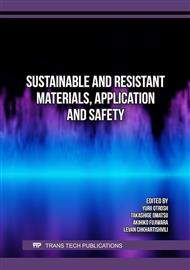[1]
Kyriakodis, G.E., and Santamouris, M.: 'Using reflective pavements to mitigate urban heat island in warm climates - Results from a large scale urban mitigation project', Urban Climate, 2018, 24, pp.326-339.
DOI: 10.1016/j.uclim.2017.02.002
Google Scholar
[2]
Chen, Y., Sha, A., Jiang, W., Du, P., Lu, Q., and Hu, K.: 'Development and evaluation of STRC coating for cooling asphalt pavement and mitigating urban heat island effects', Construction and Building Materials, 2024, 449, p.138494.
DOI: 10.1016/j.conbuildmat.2024.138494
Google Scholar
[3]
Kousis, I., Fabiani, C., and Pisello, A.L.: 'Could a bio-resin and transparent pavement improve the urban environment? An in field thermo-optical investigation and life-cycle assessment', Sustainable Cities and Society, 2022, 79, p.103597.
DOI: 10.1016/j.scs.2021.103597
Google Scholar
[4]
Jin, J., Liu, S., Gao, Y., Liu, R., Huang, W., Wang, L., Xiao, T., Lin, F., Xu, L., and Zheng, J.: 'Fabrication of cooling asphalt pavement by novel material and its thermodynamics model', Construction and Building Materials, 2021, 272, p.121930.
DOI: 10.1016/j.conbuildmat.2020.121930
Google Scholar
[5]
Shamsaei, M., Carter, A., and Vaillancourt, M.: 'Using construction and demolition waste materials to alleviate the negative effect of pavements on the urban heat island: A laboratory, field, and numerical study', Case Studies in Construction Materials, 2024, 20, pp. e03346.
DOI: 10.1016/j.cscm.2024.e03346
Google Scholar
[6]
Kousis, I., and Pisello, A.L.: 'Evaluating the performance of cool pavements for urban heat island mitigation under realistic conditions: A systematic review and meta-analysis', Urban Climate, 2023, 49, p.101470.
DOI: 10.1016/j.uclim.2023.101470
Google Scholar
[7]
De Pascale, B., Tataranni, P., Lantieri, C., Bonoli, A., and Sangiorgi, C.: 'Innovative light-coloured porous asphalt for low-impact pavements: A laboratory investigation', Construction and Building Materials, 2023, 368, p.130482.
DOI: 10.1016/j.conbuildmat.2023.130482
Google Scholar
[8]
Fang, Z., Zhang, F., Guo, Z., Zheng, Z., and Feng, X.: 'Investigation into the outdoor thermal comfort on different urban underlying surfaces', Urban Climate, 2024, 55, p.101911.
DOI: 10.1016/j.uclim.2024.101911
Google Scholar
[9]
Li, Q., Hu, T., Luo, S., Gao, L., Wang, C., and Guan, Y.: 'Evaluation of cooling effect and pavement performance for thermochromic material modified asphalt mixtures under solar radiation', Construction and Building Materials, 2020, 261, p.120589.
DOI: 10.1016/j.conbuildmat.2020.120589
Google Scholar
[10]
Gong, X., Liu, Q., Lv, Y., Chen, S., Wu, S., and Ying, H.: 'A systematic review on the strategies of reducing asphalt pavement temperature', Case Studies in Construction Materials, 2023, 18.
DOI: 10.1016/j.cscm.2023.e01852
Google Scholar
[11]
Santamouris, M., Synnefa, A., and Karlessi, T.: 'Using advanced cool materials in the urban built environment to mitigate heat islands and improve thermal comfort conditions', Solar Energy, 2011, 85, (12), pp.3085-3102.
DOI: 10.1016/j.solener.2010.12.023
Google Scholar
[12]
Zhang, X., Li, H., Jia, M., Xie, N., Kousis, I., and Santamouris, M.: 'Laboratorial investigation on optical, thermal and pavement performance of biomimetic dark reflective coatings with composite structure for pavement cooling', Building and Environment, 2024, 266, p.112057.
DOI: 10.1016/j.buildenv.2024.112057
Google Scholar
[13]
Synnefa, A., Karlessi, T., Gaitani, N., Santamouris, M., Assimakopoulos, D.N., and Papakatsikas, C.: 'Experimental testing of cool colored thin layer asphalt and estimation of its potential to improve the urban microclimate', Building and Environment, 2011, 46, (1), pp.38-44.
DOI: 10.1016/j.buildenv.2010.06.014
Google Scholar
[14]
Hu, J., Qian, Z., Liu, P., Wang, D., and Oeser, M.: 'Investigation on the permeability of porous asphalt concrete based on microstructure analysis', International Journal of Pavement Engineering, 2020, 21, (13), pp.1683-1693.
DOI: 10.1080/10298436.2018.1563785
Google Scholar
[15]
Chen, J.-S., Lee, C.-T., and Lin, Y.-Y.: 'Influence of Engineering Properties of Porous Asphalt Concrete on Long-Term Performance', Journal of Materials in Civil Engineering, 2017, 29, (4), p.04016246.
DOI: 10.1061/(asce)mt.1943-5533.0001768
Google Scholar
[16]
Li, Y.F., Yang, P.A., Wu, C.H., Cheng, T.W., and Huang, C.H.: 'A study on radiation cooling effect on asphalt concrete pavement using basic oxygen furnace slag to replace partial aggregates', Sustainability (Switzerland), 2021, 13, (7).
DOI: 10.3390/su13073708
Google Scholar
[17]
Lin, D.-F., Chou, L.-H., Wang, Y.-K., and Luo, H.-L.: 'Performance evaluation of asphalt concrete test road partially paved with industrial waste – Basic oxygen furnace slag', Construction and Building Materials, 2015, 78, pp.315-323.
DOI: 10.1016/j.conbuildmat.2014.12.078
Google Scholar


